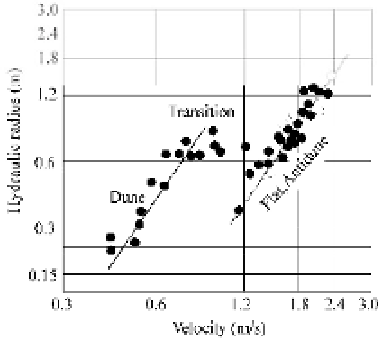Environmental Engineering Reference
In-Depth Information
sand and silt. For mountain rivers with gravel beds, no ripples, dunes and antidunes can develop, because
the particles are too course. As discussed in Chapter 3 an important vertical structure of mountain stream
bed is step-pool system.
5.1.4.2
Lower Regime and Upper Regime
Bed forms exert a drag on the flow in addition to that associated with the grains themselves. On the
upstream side of an obstacle, the rising bed elevation causes an acceleration of the flow and a commensurate
decrease in pressure. Beyond the crest of the obstacle, depth and pressure increase, and the flow
decelerates. This effect, which produces pressure gradients, gives rise to form drag. This conclusion is
only for ripples and dunes. The bed forms of ripples and dunes belong to the category of the lower flow
regime, defined by Simons and Richardson (1966).
Bed forms of flat bed and antidunes are in the category of the upper regime. In the upper regime, the
form drag reduces to nearly zero because the bed form and the water surface are in phase and grain
roughness dominates in the flow. There is no pressure difference on the upstream and downstream sides
of the antidunes. If a flow develops from lower regime to upper regime, the roughness n may reduce by
50% at the same flow discharge and the flow depth may reduce by 20%. Simons and Richardson (1966)
measured the Weisbach friction factor
f
( 8
sgR/U
2
) in their experiments, and found it varied with the
type of bed form:
Lower flow regime: Dunes: 0.04
İ
f
İ
0.16
Upper flow regime: Antidunes: 0.02
İ
f
İ
. 7 ( . )
The transformation from the lower flow regime to the upper flow regime occurs if the stream power
increases or the fall velocity reduces (Simons and Richardson, 1966). At a given discharge and sediment
composition, if the water temperature reduces, the fall velocity of the sediment consequently reduces,
and the bed form may develop from the lower regime into the upper regime. The resistance or roughness
may abruptly reduce and the flow velocity may increase dramatically. Sediment transportation may
greatly increase in a short time.
The same situation can also occur in natural streams. For the same slope and water depth, the bed may
form dunes, or be flat without dunes, and the resistances for these two cases are quite different;
correspondingly, the velocities are also different. As a result, different unit discharges can flow at the
same slope and water depth. Figure 5.16 shows the relation between the hydraulic radius and velocity
measured for the Rio Grande River in the U.S. (Culbertson and Nordin, 1960). For a hydraulic radius of
Fig. 5.16
Relation between hydraulic radius and velocity for the Rio Grade River, U.S. and the effect of bed forms
from the lower flow regime to the upper flow regime (after Culbertson and Nordin, 1960)


Search WWH ::

Custom Search